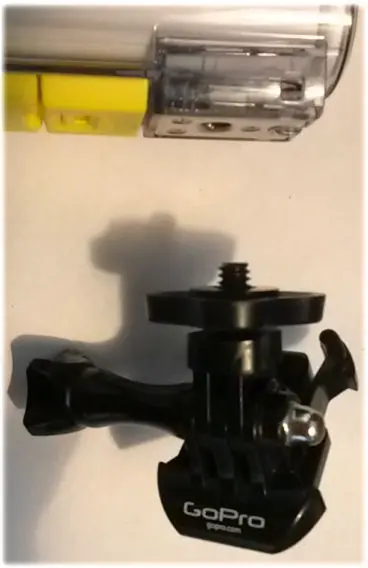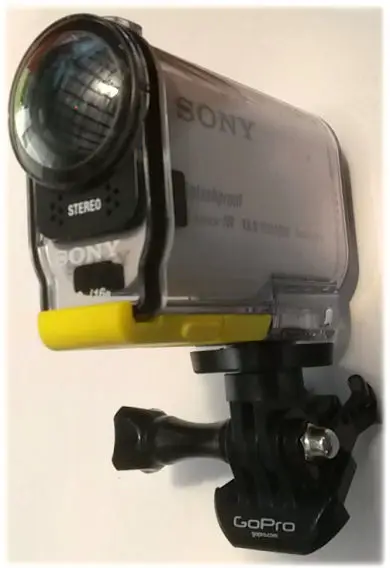
|

![]()
![]()
I took the opportunity to try out the Sony HDR-AS100V action camera at the 2014 Interbike bicycle trade show's Outdoor Expo. I have used it frequently since then.
The Sony camera has a feature which I'd long been hoping for: image stabilization. The camera also has stereo sound recording, wireless connectivity and GPS. I find all of those features appealing.
Here's some video I shot at the Interbike Outdoor Expo. For the clips in this video, the camera's image stabilization was turned on. It is effective, though less than perfect when camera shake is extreme. Following the video, I'll show how to make the image stabilization approach perfection, with some post-production work.
sony-as100 from John Allen on Vimeo.
![]()
![]()
For me, the most exciting new feature of the Sony camera is the image stabilization, so I'm going to discuss that -- and how to improve on that.
Digital image stabilization can only reposition the image once it has been taken -- not during exposure -- so blur can still occur. This problem is worst in dim light, when exposure time for each image is longer.
The Sony camera's digital image stabilization works very well in bright light and for moderate camera shake. No blur is noticeable in daylight. I suspect also that the Sony's stabilization is tailored to the camera's ultra wide-angle fisheye lens. Even with extreme shaking when I was riding on a bumpy surface and with the camera mounted on my helmet, I didn't notice any changes in image geometry due to the image stabilization, suggesting that the camera's software knows to adjust different parts of the image differently, though they look in different directions -- also probably compensating for the camera's rolling shutter, which scans the image from top to bottom, exposing different parts at different times.
If you mount this camera or any camera rigidly on a bicycle, there will be high-frequency vibrations which no image stabilization can remove. I prefer to mount the camera on my helmet, producing larger but more easily corrected bobbles. The Sony's image stabilization does a good job of removing large shakes and large image excursions, but it did not correct for all image rotation in my test. Also, small, shakes still remain when the corrections have been extreme.
Here's my dirty-lens clip from the previous video, processed additionally with Deshaker image stabilization software. Thanks to the camera's internal stabilization, the image excursions which Deshaker must correct are small, and so no noticeable distortion of image geometry results from Deshaker's processing. Considering the bumpiness of the ride, the results are remarkable. The YouTube version of this clip is a bit jerky, but the panning is perfectly smooth when I view the file on my computer. Neither the camera nor Deshaker alone can achieve results like this.
Here's a longer version of my more challenging BMX-track clip after processing in Deshaker. This clip took image stabilization to its limits and isn't quite perfect until I get out onto the merely bumpy dirt road, but the results are very good, and if I'd held my head steadier, they would be better yet. Again, this clip looks much jerkier over YouTube.
Deshaker has an easier job if you run the camera at 60 rather than 30 frames per second -- available with this camera in 1080-line mode-- and then after running Deshaker, convert to 30 frames per second (progressive, using every second frame, or interlaced, using every frame) as needed. Also, because the camera's image stabilization compensates for its rolling shutter, do not select "rolling shutter" while running Deshaker.
The article about Deshaker linked at the end of thsi article offers additional advice on settings.
![]()
![]()
An online video review (see below) describes the AS100V as adapting well and quickly to changes in lighting, and as performing well in low-light. As I've already remarked, the image stabilization doesn't work as well in low light: the review revealsis camera-motion blur, as is to be expected.
The camera has numerous shooting modes including high-frame-rate, slow-motion, time-lapse and still-photo modes, also described in detail in the online video review.
The flat bottom of the camera allows it to be stood up on a surface. There is a tripod mount attachment which fits either directly to the camera or to the waterproof case. There are jacks for an external microphone, a proprietary input-output cable, HDMI video output and USB/power input cable. The jacks are all on the underside of the camera. If you use the tripod mount, or most of the fittings which Sony provides to attach the camera to anything, only the USB connector remains exposed, though you still can run the camera on external power unless it is sitting on top of something which blocks the USB cable. Having the door open negates the camera's splashproof feature, though.
There's an optional skeleton case which appears to allow all of the cables to exit, because the tripod attaches at the side, or you could use Ductape or a do-it-yourself fitting. The camera does have a "flip" image mode so you can run it upside down with the cables coming out the top. I especially regret not being able to use an external microphone, I'm wondering whether a firmware upgrade might allow wireless connection of an external microphone. That would be even better than a wired one.
Sony offers several attachments and options. The wireless remote control shown in my video displays what the camera is seeing. There are also an available enclosure with a fold-out viewscreen, and software to show clips from the camera on smartphones. Another software option, for Windows or Mac, adds a display from the camera's GPS recording to video clips. A Web search will find vendors of the camera, accessories and software.
Sony's snap-in quick-release base is different from the common GoPro base. An optional GoPro tripod-screw mount (do an image search on "GoPro tripod adapter" and look for ones with a protruding threaded stud), bolted to a GoPro snap-in base as in the photos below, works with the Sony camera either in its shell or bare. Standardizing on the GoPro base makes all of your cameras compatible with all of the mountings you may use. The camera can be removed from its shell when using either the Sony mounting kit, or this one.


The Zeiss lens protrudes at the front of the camera -- as it must to shoot such a wide-angle view -- and so it it vulnerable to scratching or breakage. Using the camera on a bicycle or motorcycle where there is blowing sand will degrade the lens. Sony offers a protective, transparent lens cap which is useful in such situations. It will result in additional lens flare due to reflections from the additional glass surfaces.
The splashproof feature is described as allowing the camera to be used in rain without damage. the waterproof case allows the camera to be used for diving as deep as 16 feet, and also protects the lens, but prevents attachment of cables and makes audio sound tinny. As my ride-test video shows, wind noise with the bare camera, while certainly present, is not as overwhelming as it is with many other cameras. With the camera in the case, wind noise is less strong but so is the other audio..
I can't much for the bicycle handlebar clamp mount: every one of them in the Sony booth at the Outdoor Demo had a loose pivot, after less than two days of rough off-road use. The standard tripod mount and slide-in bracket, however, allow many other kinds of hardware to be pressed into service.
![]()
![]()
A British man (Matt, "Techmoan") who has a very systematic approach and a good sense of humour (hey, he's British) produces reviews of action cameras. He took the AS100V out in a car and on a motorcycle, and walking. His video review (embedded below) is long and detailed, though he did not do an extreme image stabilization test as I did. He prefers the AS100V over the top-of-the-line GoPro. Also check out the description and comments with the video on YouTube, and his blog post about the camera.
![]()
![]()
Last Updated: by John Allen